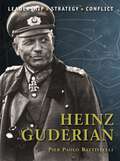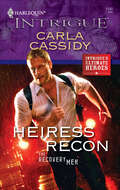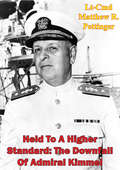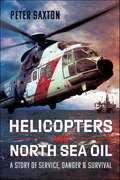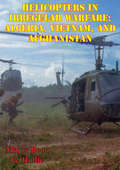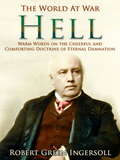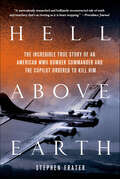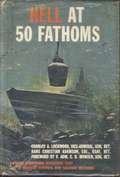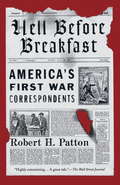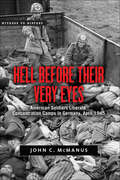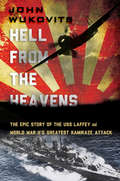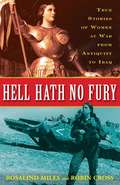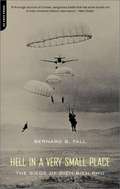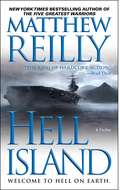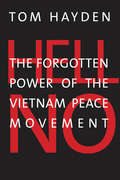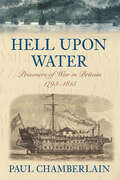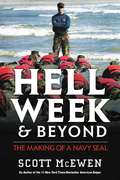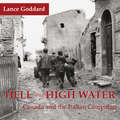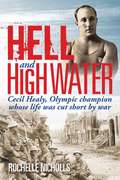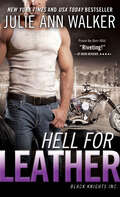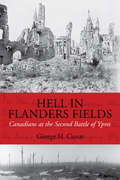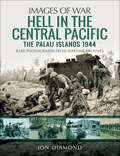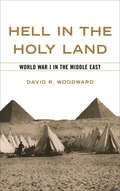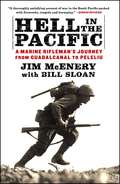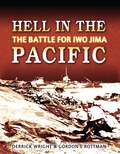- Table View
- List View
Heinz Guderian
by Adam Hook Pier BattistelliThis book gives a focused, military biography of Heinz Guderian, perhaps the most highly respected German tank commander of World War II. Guderian was a typical product of the Prussian military elite; the son of a general in the army, there was little doubt that he would follow in his father's footsteps. Some consider Guderian to be the founding father of blitzkrieg warfare, and he certainly brought the whole concept to public attention and prominence, chiefly through the publication of his book Achtung Panzer in 1937. He commanded the XIX Motorized) Army Corps in the 1939 Polish campaign, and Panzergruppe Guderian during Operation Barbarossa. In March 1943 he became chief inspector of the Panzer forces, but even the great tank commander could achieve little more than to delay the inevitable defeat of Germany.
Heiress Recon (The Recovery Men #2)
by Carla CassidyBrianna Waverly had barely escaped death once. So she had little choice but to accept the protection of former navy SEAL Troy Sinclair. Spirited away to a tiny cabin, her safe house was as far removed from her heiress lifestyle as she could imagine. And her bodyguard so much more exciting than any man she'd ever known.Troy wasn't pleased to be playing house when danger lurked behind every door. Especially when the woman he had to protect was proving impossible to resist. But emotion was an entanglement he couldn't afford...because the ultimate price would be their lives.
Held To A Higher Standard: The Downfall Of Admiral Kimmel
by Lt-Cmd Matthew R. PettingerIn the aftermath of the Japanese attack on Pearl Harbor, Admiral Husband Kimmel was relieved of command of the United States Pacific Fleet and forced into retirement. Eight official investigations were conducted to determine his accountability for the attack. These investigations produced mixed and often contradictory findings. Though he was never brought to court-martial, accusations of dereliction of duty damaged his reputation considerably. Ultimately, he was one of only two World War Two flag officers not to be retired at the highest rank held during the war; the other was Lieutenant General Walter Short, the Army's Hawaiian commander at the time of the attack. In contrast, only nine hours after the Pearl Harbor attack, General Douglas MacArthur suffered a similar crushing surprise defeat in the Philippines despite his knowledge that the Japanese had initiated hostilities. Yet, he became a national war hero. The differing treatment accorded Admiral Kimmel compared to General MacArthur stands as a lesson on biased judgement. Today, military commanders in the Global War on Terrorism may find themselves in circumstances similar to either of these two commanders. Knowledge of their situations may help today's commanders avoid similar pitfalls, or may prevent comparable unbalanced treatment.
Helicopters and North Sea Oil: A Story of Service, Danger and Survival
by Peter SaxtonA series of personal accounts by highly trained helicopter pilots, including those with distinguished careers in the military and commercial flying, who with divers, ensured that essential staff could operate in North Sea oil exploration and oil supply. They were the vital link in the process and operated in the most challenging circumstances, often in high levels of danger and sometimes with loss of life, for example, the Piper Alpha Disaster which made national news. And the ferrying of essential personnel and supplies could involve rescues as well routine flying missions. The narrative is often technical but written to ensure good understanding for lay readers and it will, of course, appeal to the many with flying experience in the forces, in commercial flying and government service. Above all, it is a series of graphic personal stories as recounted by individuals faced with extremes of climate, weather, technical, engineering and aeronautical problems and often with human life at stake. The people come to life and with domestic and social concerns and interests are 'real' and believable people. It is history of the North Sea oil episode in UK political and economic history and in conjunction with international oil politics is of huge importance to Britain's economy. This is a period of progress to domestic oil independence by about 1984 and so a key period with subsequent importance even to the present. All aspects of the operations are covered within individual stories, and include the broader questions of company policy, regulation, and trade union involvement.
Helicopters in Irregular Warfare: Algeria, Vietnam, and Afghanistan [Illustrated Edition]
by Major Beau G. RollieIncludes 3 maps and more than 10 illustrationsThe preponderance of conflicts fought over the last seventy years have included or been centered on irregular warfare and counter-insurgency. Indeed, the helicopter's first significant trials in combat took place during the Algerian War 1954-1962, the Vietnam War 1955-1975, and the Soviet-Afghan War 1979-1989. During these wars, French, U.S., and Soviet militaries used significant numbers of helicopters to fight insurgents and guerrillas, and each country lost their respective conflict. As conventional organizations, these militaries used helicopters to seek military dominance, often blind to or in spite of politico-strategic goals like legitimacy. The helicopter's firepower and mobility tactically decimated insurgents, but the nature of irregular warfare rendered tactical dominance indecisive. Helicopters were indecisive or bad at enabling legitimacy, population control, and isolation, key tenets of successful COIN. Convinced that helicopter enabled military dominance could win, the French, U.S., and Soviet militaries were unable to balance the pursuit of military and politically objectives. Airmobility distracted leaders from focusing on the political aspects of counter-insurgency.
Hell / Warm Words on the Cheerful and Comforting Doctrine of Eternal Damnation (The World At War)
by Robert IngersollRobert Green "Bob" Ingersoll (August 11, 1833 – July 21, 1899) was an American lawyer, a Civil War veteran, political leader, and orator of United States during the Golden Age of Free Thought, noted for his broad range of culture and his defence of agnosticism. He was nicknamed "The Great Agnostic". His radical views on religion, slavery, woman's suffrage, and other issues of the day effectively prevented him from ever pursuing or holding political offices higher than that of state attorney general. Illinois Republicans tried to pressure him into running for governor on the condition that Ingersoll conceal his agnosticism during the campaign, which he refused to do on the basis that concealing information from the public was immoral. (Excerpt from Wikipedia)
Hell Above Earth: The Incredible True Story of an American WWII Bomber Commander and the Copilot Ordered to Kill Him
by Stephen Frater"After the twists and turns in Goering's many missions, Frater finishes with a stunning revelation . . . the author delivers an exciting read full of little-known facts about the war. A WWII thrill ride." - Kirkus Reviews The U.S. air battle over Nazi Germany in WWII was hell above earth. For bomber crews, every day they flew was like D-Day, exacting a terrible physical and emotional toll. Twenty-year-old U.S. Captain Werner Goering, accepted this, even thrived on and welcomed the adrenaline rush. He was an exceptional pilot—and the nephew of Hermann Göring, leading member of the Nazi party and commander-in-chief of the Luftwaffe. The FBI and the American military would not prevent Werner from serving his American homeland, but neither would they risk the propaganda coup that his desertion or capture would represent for Nazi Germany. J. Edgar Hoover issued a top-secret order that if Captain Goering's plane was downed for any reason over Nazi-occupied Europe, someone would be there in the cockpit to shoot Goering dead. FBI agents found a man capable of accomplishing the task in Jack Rencher, a tough, insular B-17 instructor who also happened to be one of the Army's best pistol shots. That Jack and Werner became unlikely friends is just one more twist in one of the most incredible untold tales of WWII.
Hell At 50 Fathoms
by Colonel Hans Christian Adamson Vice-Admiral Charles A LockwoodHell at 50 Fathoms, written by Vice Admiral Charles A. Lockwood and Colonel Hans Christian Adamson, tells the story of submarine accidents of the United States Navy. It describes the bone-chilling experiences of valiant sailors who risked their lives to perfect underwater craft.Vice Admiral Lockwood, so well-known to submariners as the World War II Commander of the Submarine Force, U.S. Pacific Fleet, has always been interested in diving and all other underwater exploits. This interest was exemplified when, in July 1943, he led a group of swimmers in the recovery of a live torpedo. The torpedo had been test fired against a cliff in an effort to discover the cause of faulty exploders. This effort was successful. The fault was disclosed and corrected, much to the relief of submarine captains who had seen so many torpedoes bounce off Japanese ships without exploding. Lockwood was awarded the Legion of Merit for this conspicuous gallantry.This is a striking example of the resourcefulness inbred in submarine sailors. Each mishap discloses a weakness that is corrected. The tragedy of the sinking of the S-4 brought forth, with stunning forcefulness, the inadequacy of our technical competency to deal with a simple rescue problem. Within the steel hull of the S-4, brave men hammered out signals pleading for help--help that never came. Using the restored S-4 as an experimental laboratory, the Navy produced dramatic results in learning how entrapped men can escape, how surface crews can rescue them, and how to salvage a submarine for further service.--C. B. Momsen, Vice Admiral, USN (Ret.)
Hell Before Breakfast: America's First War Correspondents Making History and Headlines, from the Battlefields of the Civil War to the Far Reaches of the Ottoman Empire
by Robert H. PattonThe first "war correspondent," William H. Russell of The Times of London, described himself and his profession as "the miserable parent of a luckless tribe." Others saw it differently: the war correspondent became the stuff of dreams and an urgent romantic calling. . . . Now, Robert H. Patton, acclaimed historian, author of The Pattons ("Exceptional"--The Washington Post; "Truly remarkable"--John S. Eisenhower) and Patriot Pirates ("Soul-stirring--as good as reading a Patrick O'Brian novel, except that every word is true"--Michael Korda), rediscovers and celebrates, in Hell Before Breakfast, America's first war correspondents, forgotten today but legends in their time. Here are the men who, between 1850 and 1914, and particularly during America's Civil War and the Spanish-American War, led the most romantic and thrilling of lives on the edgiest frontiers of time and space, where empires fell and dynasties flourished; they were correspondents who saw the world, broke the story, were making the news during the years when newspapers made available the most foreign of landscapes and their circulation wars were revolutionizing contemporary life, shaping global events, and creating history. Patton writes of the decades of lightning progress and high adventure, when America was emerging as a great power and the monarchies of Europe battled for dominance through a series of brief, bloody imperial wars; when the newly discovered electric telegraph enabled these extraordinary first-person dispatches to be splashed across the daily newspapers then proliferating on both sides of the Atlantic. Through the eyes (and minds) of American adventurers, soldiers, and artists-turned-correspondents--Mark Twain and the painter John Millet among them--we see what they saw and what they brought to life: the Civil War, the Austro-Prussian War, the Franco-Prussian War, the Russo-Turkish War. Patton writes about New York Herald reporter Henry Stanley, who led a caravan from the Tanzanian coast into the uncharted "cannibal country" and, after a 236-day trek, discovered the long lost and presumed dead Dr. David Livingstone . . . about Archibald Forbes of the London Daily News bringing to life in his dispatches the frantic assembly of barricades along Paris streets as royalists and Communists fought with bayonets following the Prussian invasion. Here are the fearless young correspondents, among them Henry Villard of Bavaria, a journalist who covered the Civil War and ended up a financial titan, head of the Northern Pacific Railway and an early investor in the company that would ultimately become General Electric; and George Smalley, chief war correspondent of the New York Tribune, who watched for twenty-four hours as the Union Army of the Potomac and the Confederate Army of Northern Virginia fought in the cornfields and woodlands around Antietam Creek. These correspondents were at center stage and, through their on-the-spot reporting, became legends in their time. Their intrepid spirit and sense of adventure inspired generations of storytellers, explorers, artists, writers, statesmen and politicians, and even moviemakers--from Rudyard Kipling and Winston Churchill to Theodore Roosevelt, D. W. Griffith, and Cecil B. DeMille--men whose adolescence was shaped during this spectacular age of war correspondence.From the Hardcover edition.
Hell Before Their Very Eyes: American Soldiers Liberate Concentration Camps in Germany, April 1945 (Witness to History)
by John C. McManusThe life-altering experiences of the American soldiers who liberated three Nazi concentration camps.On April 4, 1945, United States Army units from the 89th Infantry Division and the 4th Armored Division seized Ohrdruf, the first of many Nazi concentration camps to be liberated in Germany. In the weeks that followed, as more camps were discovered, thousands of soldiers came face to face with the monstrous reality of Hitler’s Germany. These men discovered the very depths of human-imposed cruelty and depravity: railroad cars stacked with emaciated, lifeless bodies; ovens full of incinerated human remains; warehouses filled with stolen shoes, clothes, luggage, and even eyeglasses; prison yards littered with implements of torture and dead bodies; and—perhaps most disturbing of all—the half-dead survivors of the camps. For the American soldiers of all ranks who witnessed such powerful evidence of Nazi crimes, the experience was life altering. Almost all were haunted for the rest of their lives by what they had seen, horrified that humans from ostensibly civilized societies were capable of such crimes. Military historian John C. McManus sheds new light on this often-overlooked aspect of the Holocaust. Drawing on a rich blend of archival sources and thousands of firsthand accounts—including unit journals, interviews, oral histories, memoirs, diaries, letters, and published recollections—Hell Before Their Very Eyes focuses on the experiences of the soldiers who liberated Ohrdruf, Buchenwald, and Dachau and their determination to bear witness to this horrific history.
Hell From the Heavens: The Epic Story of the USS Laffey and World War II's Greatest Kamikaze Attack
by WukovitsOn the morning of April 16, 1945, the crewmen of the USS Laffey saw what seemed to be the entire Japanese air force assembled directly above. They were about to become the targets of the largest single-ship kamikaze attack of World War II. By the time the unprecedented assault was finished, thirty-two sailors were dead and more than seventy wounded. Although she lay shrouded in smoke and fire for hours, the Laffey somehow survived. The gutted American warship limped from Okinawa’s shore for home, where the ship and crew would be feted as heroes. Using personal interviews with survivors, the memoirs of crew members, and their wartime correspondence, John Wukovits breathes life into the story of this forgotten historic event.
Hell Hath No Fury: True Stories of Women at War from Antiquity to Iraq
by Rosalind Miles Robin CrossAn engaging collection that uncovers injustices in history and overturns misconceptions about the role of women in war. When you think of war, you think of men, right? Not so fast. In Hell Hath No Fury, Rosalind Miles and Robin Cross prove that although many of their stories have been erased or forgotten, women have played an integral role in wars throughout history. In witty and compelling biographical essays categorized and alphabetized for easy reference, Miles and Cross introduce us to war leaders ...
Hell In A Very Small Place: The Siege Of Dien Bien Phu
by Bernard B. FallThe 1954 battle of Dien Bien Phu ranks with Stalingrad and Tet for what it ended (imperial ambitions), what it foretold (American involvement), and what it symbolized: A guerrilla force of Viet Minh destroyed a technologically superior French army, convincing the Viet Minh that similar tactics might prevail in battle with the U. S.
Hell Island
by Matthew ReillyCaptain Shane Schofi eld and his elite team of marines is about to discover . . .There is no hell like a man-made one.It is an island that doesn’t appear on any maps. A secret location where the government conducts classified experiments. Experiments that have gone terribly wrong. . . . When all contact with the mysterious island is suddenly and inexplicably lost, Captain Shane Schofi eld and four crack Special Forces units parachute in. Nothing prepares them for what they fi nd—the island is a testing ground for a deadly breed of genetically enhanced supersoldiers. You could say they’ve just entered hell, but this place is much, much worse. . . .
Hell No: The Forgotten Power of the Vietnam Peace Movement
by Tom HaydenWhy those who protested the Vietnam War must be honored, remembered, and appreciated "Hell no" was the battle cry of the largest peace movement in American history--the effort to end the Vietnam War, which included thousands of veterans. The movement was divided among radicals, revolutionaries, sectarians, moderates, and militants, which legions of paid FBI informants and government provocateurs tried to destroy. Despite these obstacles millions marched, resisted the draft on campuses, and forced two sitting presidents from office. This movement was a watershed in our history, yet today it is in danger of being forgotten, condemned by its critics for everything from cowardice to stab-in-the-back betrayal. In this indispensable essay, Tom Hayden, a principal anti-Vietnam War organizer, calls to account elites who want to forget the Vietnam peace movement and excoriates those who trivialize its impact, engage in caricature of protesters and question their patriotism. In so doing, he seeks both a reckoning and a healing of national memory.
Hell Upon Water: Prisoners of War in Britain 1793-1815
by Paul ChamberlainDuring the French Revolutionary and Napoleonic Wars, over 200,000 prisoners of war of many nationalities were brought to Britain to be held in the infamous prison hulks, land prisons and parole depots. Many prisoners languished in captivity for over eleven years. This book tells the story of these men and women. Hell Upon Water examines how prisoners of war were acquired by the British, how they were fed, clothed and accommodated by the Transport Board of the Admiralty. The larger prisons such as Dartmoor, Portchester Castle and Norman Cross are described in detail, alongside the smaller lesser known depots of Forton, Stapleton, and Mill Bay. It compares the treatment of French prisoners with that of Britons in France, and also tells the stories of officers who fell in love with local girls and married, and those who fought to escape.
Hell Week and Beyond: The Making of a Navy SEAL
by Scott McEwenFollow America's elite warriors through the military's most grueling training and learn how they survive real special operations.Of the 18 months required to become a Navy SEAL, one week will cause over half of the trainees to quit ("ring the bell"). Only the toughest make it through. In Hell Week and Beyond, Scott McEwen takes the readers to the sands of Coronado Beach in San Diego, where Navy SEALs are put through the most grueling training known to mankind. Grit, commitment, heart, and soul are needed to become a SEAL, because these are the elite forces who go into the toughest battles for America.Many of the most well-known SEAL warriors have been interviewed for this book, providing the stories of what got them through and the humor of those that made it. (Those that make it almost always have one thing in common: humor. Find out why!)Part Top Gun, part Bull Durham, this book delivers that goods for those in the know, as well as general readers who admire the elite forces for all they do.
Hell and High Water
by Lance GoddardAlthough it has been overshadowed by other events of the Second World War, Canada’s role in the Italian Campaign, from 1943 to 1945, was significant. Canadian forces played a major role in this campaign, whose goal was to open a second front in order to ease the pressure on Russian forces in the east. Canada fought under British command alongside British and American units, but our soldiers saw some of the fiercest fighting and achieved glory many times, including at the Battle of Ortona, one of Canada’s greatest military accomplishments.The pictorial history examines the Italian Campaign from the view of the soldiers serving there. Regiments represented in interviews in this book include the Princess Patricia’s Light Infantry, the Perth Regiment, the Governor-General’s Horse Guards, the Ontario Regiment, the 48th Highlanders, the Calgary Regiment, the Hastings and Prince Edward Regiment, the Royal Canadian Dragoons, and the Royal Canadian Navy.
Hell and High Water: Cecil Healy, Olympic Champion whose life was cut short by war
by Rochelle NichollsThe golden boy of Australian swimming and captain of the lifeguards on Manly Beach, Cecil Healy was the poster-boy for all that was decent in Australia before World War I. Powerful, bronzed and daring, his fearlessness made him a leader in the embryonic surf-lifesaving movement, and his unique crawl stroke captured swimming records across the globe. Healy became the darling of the Olympic movement in 1912 when he allowed a disqualified rival to swim and take the 100 metres freestyle title, sacrificing almost certain victory for fair play and honour. But Cecil Healy’s seemingly perfect life was beset by darkness and secrets. His repressed sexuality and inner demons drove him to acts of recklessness which would culminate in his supreme sacrifice on the battlefields of France. As World War I raged, the Olympic champion refused to remain protected behind the lines. His death on the Somme in 1918, charging a German machine-gun post, embodies the tortured self-destructiveness which still drives many male sportsmen to both glory and disaster. Cecil Healy remains the only Australian Olympic gold medallist to have given his life in the theatre of war. This book chronicles both Healy’s glittering sports performances and the torment behind this great, lost Olympian.
Hell for Leather (Black Knights Inc. #6)
by Julie Ann WalkerA New York Times and USA Today Bestseller!Black Knights Inc.—Behind the facade of their tricked–out motorcycle shop is an elite special ops team assigned the jobs too hot for anyone else to handle.One of Booklist's 101 Best Romance of the Last 10 YearsOnly the most urgent crisis could persuade Delilah Fairchild to abandon her beloved biker bar. But her uncle has vanished into thin air and she must turn to the sexy, surly Black Knights Inc. operator for help.Delilah is certain that Bryan "Mac" McMillian has the connections to help her find her uncle. What the big, blue-eyed, former FBI agent has against her is a mystery, but when bullets start to fly, Mac becomes her only hope of survival, and her only chance at finding her uncle alive.Mac knows a thing or two about beautiful women—mainly that they can't be trusted. Throw in a ticking clock, a deadly homegrown terrorist, and some missing nuclear weapons, and a man just might find himself on the wrong end of a gun. But facing down danger with Delilah is one passion-filled thrill ride.The perfect combination of humor, suspense, and romance, Hell for Leather is non-stop explosive action. Readers of Suzanne Brockman, Maya Banks and Tara Janzen will be rooting for Delilah and Mac, two favorites from the bestselling Black Knights Inc. series. Black Knights Inc. Series Hell on Wheels (Book 1) In Rides Trouble (Book 2) Rev It Up (Book 3) Thrill Ride (Book 4) Born Wild (Book 5) Hell for Leather (Book 6) Full Throttle (Book 7) Too Hard to Handle (Book 8)Wild Ride (Book 9 — coming April 2017!)What readers are saying about Hell for Leather:"smoking hot""the perfect blend of action, romance, [and] humor…""an unforgettable, unputdownable read.""This book is a must read in this series…""The story flowed seamlessly and there was no way I could put it down.""If you want a book that's hard to put down, that will leave you thinking about it for weeks after, and one that you will absolutely L O V E, then get this N O W."
Hell in Flanders Fields: Canadians at the Second Battle of Ypres
by George H. CassarOn 22 April 1915, the men of the 1st Canadian Division faced chlorine gas, a new lethal weapon against which they had no defence. In defiance of a particularly horrible death, or, at the very least, severe lung injury, these untested Canadians fought almost continuously for four days, often hand-to-hand, as they clung stubbornly against overwhelming odds to a vital part of the Allied line after the French units on their left fled in panic. By doing so, they saved 50,000 troops in the Ypres salient from almost certain destruction, and, in addition, prevented the momentum of the war from tipping in favour of the Germans. In this new, deeply researched account, the distinguished military historian George H. Cassar skillfully blends into the history of the battle the graphic and moving words of the men on the front line. Illustrated with outstanding photographs and numerous maps, and drawing from diaries, letters, and documents from every level of planning, Hell in Flanders Fields is an authoritative, gripping drama of politics, strategy, and human courage.
Hell in the Central Pacific 1944: The Palau Islands (Images Of War Ser.)
by Jon DiamondThis WWII pictorial history covers a little-known but hard-fought Pacific War campaign with striking combat images and expertly researched text.In September 1944, to prevent Japanese air interdiction against General MacArthur’s invasion of the Southern Philippines, the Americans attacked Peleliu and Angaur in the Palau group of the Western Caroline Islands. Admiral Halsey, commanding the US Third Fleet, feared the heavily defended Palaus would be costly for his III Amphibious Corps.While Angaur fell in four days, the Japanese resisted tenaciously on Peleliu thanks to their underground fortifications on the Umurbrogel Ridge overlooking the airfield. It took more than two months of bitter fighting to take control of the Island—and the benefits of this costly victory were doubtful. But as Jon Diamond demonstrates in this fully illustrated volume, there is no denying the courage and determination shown by the attacking US forces.
Hell in the Holy Land: World War I in the Middle East
by David R. WoodwardThis compelling WWI history reveals the harsh realities of the British Army’s Middle East campaign through the firsthand accounts of soldiers.The massive flow of British troops and equipment to Egypt made that country host to the largest British military base outside of Britain and France. Though many soldiers found the atmosphere in Cairo exotic, the desert countryside made operations extremely difficult. The intense heat frequently sickened soldiers, and unruly camels were the only practical means of transport across the soft sands of the Sinai. The constant shortage of potable water was a persistent problem for the troops.Drawing on the diaries, letters, and memoirs of British soldiers who fought in Egypt and Palestine, David R. Woodward paints a vivid picture of the mayhem, terror, boredom, filth, and sacrifice they endured. The voices of these soldiers offer a forgotten perspective of the Great War, describing not only the physical and psychological toll of combat but the daily struggles of soldiers who were stationed in an unfamiliar environment that often proved just as antagonistic as the enemy.
Hell in the Pacific
by Bill Sloan Jim MceneryIn what may be the last memoir to be published by a living veteran of the pivotal invasion of Guadalcanal, which occurred almost seventy years ago, Marine Jim McEnery has teamed up with author Bill Sloan to create an unforgettable chronicle of heroism and horror. McENERY'S RIFLE COMPANY--the legendary K/3/5 of the First Marine Division, made famous by the HBO miniseries The Pacific--fought in some of the most ferocious battles of the war. In searing detail, the author takes us back to Guadalcanal, where American forces first turned the tide against the Japanese; Cape Gloucester, where 1,300 Marines were killed or wounded; and bloody Peleliu, where McEnery assumed command of the company and helped hasten the final defeat of the Japanese garrison after weeks of torturous cave-to-cave fighting. McEnery's story is a no-holds-barred, grunt's-eye view of the sacrifices, suffering, and raw courage of the men in the foxholes, locked in mortal combat with an implacable enemy sworn to fight to the death. From bayonet charges and hand-to-hand combat to midnight banzai attacks and the loss of close buddies, the rifle squad leader spares no details, chronicling his odyssey from boot camp through twenty-eight months of hellish combat until his eventual return home. He has given us an unforgettable portrait of men at war.
Hell in the Pacific
by Derrick WrightThe battle of Iwo Jima was extraordinary for its ferocity. US Marine Corps casualties exceeded by thousands the number of Japanese defenders, who fought almost to the last man over those five desperate weeks. The strategic justification for the mission has been challenged and the iconic photograph of the flag-raising was staged, but there is no questioning the courage displayed (winning the USMC 24 Medals of Honor) and the horrors endured by both sides. The Japanese were dug into a vast and complex defensive network of trenches, bunkers, caves and tunnels commanding every square foot of the island's volcanic rock and black sand. The Marines' task was to fight almost every step of the way from their landing beaches to the northern tip where victory was finally secured, developing new tactics to deal with this well-entrenched, determined and heavily-armed resistance as they progressed from objective to objective. This book details the composition, weaponry and leadership of the opposing forces and reviews their plans. It also closely examines the individual fighting men on each side, the USMC infantryman and the Imperial Japanese soldier, contrasting their training, equipment, culture and battlefield experiences. Having laid out the background, the authors then follow the battle through its several phases from the landings to General Kuribayashi's last banzai. Their clear narrative, supported by numerous maps, tactical diagrams and photographs, answers in detail the question which other accounts of this great battle only address at a more general level: how did the Marines do it?From the Hardcover edition.
